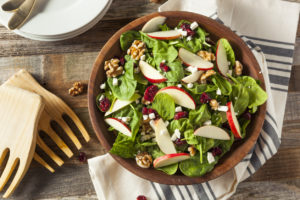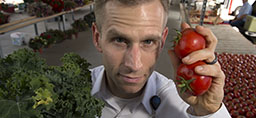
The secret to weight loss may not be as secretive as we think.
We don’t need to run a mighty marathon or live on cabbage soup and water. All we may need to do to say goodbye to packed-on pounds is to say hello to portion recognition.
Mary Dagen, MD, an obesity medicine specialist with the Spectrum Health Weight Loss Clinic in Grand Haven, Michigan, said restaurants may have tricked our tummies into believing what they’re serving up is a healthy and necessary portion.
Not true, she says.
“Restaurants in general are serving 200 percent bigger portions than what we need,” Dr. Dagen said. “People would be better off splitting meals. But some may say, ‘What do you mean, you want me to split my steak?’”
Meat servings are a big, no pun intended, part of the problem.
While a 4-ounce portion, about the size of your palm, is recommended and considered a healthy portion, how many times do you see a 4-ounce steak on the menu?
“Some restaurants may have a 6-ounce steak, but it’s usually 8 or 10 ounces,” Dr. Dagen said.
And what sides comes with that super-sized steak? Baked potato and sweet corn perhaps?
“That’s what we tend to eat as Michiganders, and they’re the highest in sugar, as far as vegetables go,” she said.
Love a traditional fast-food meal?
Your waistline doesn’t. Not these days, anyway.
“In comparison to what a hamburger, fries and Coke used to look like, you’re consuming 800 more calories now just in that meal alone,” she said. “It’s because it’s so cheap to produce these products. It’s just not good food.”
But hamburgers and fries aren’t the only items that have supersized.
A bagel contains 250 to 300 more calories than a bagel from 20 years ago.
“That’s how much a meal should be—250 to 300 calories,” Dr. Dagen said.
As portions have grown larger, so have the people consuming them.
“Look at movie popcorn—it’s crazy what a ‘small’ is now days,” she said. “Things have drastically changed.”
When Dr. Dagen gives presentations on healthy eating and portion sizes, she said the proof is in what the audience members carry with them.
“Universally, somebody has a 20-ounce bottle of something with them,” she said. “If you look at the serving size of a bottle of water, it serves two and a half people. If you look at the serving size of a bottle of soda, it has always said it serves one. So, if people are looking at serving sizes, they could think they can drink the entire bottle of soda but should share their water. It’s amazing to see what the difference in portions has become.”
Take pizza for example.
Two decades ago, two slices of pepperoni pizza clocked in at 400 calories.
“Now, if you eat two slices, not even stuffed crust, it’s 900 calories,” Dr. Dagen said. “And how many of us eat just two slices? They make skinny slices which I find hilarious. That’s the size it used to be. I think in general, we are eating way too much.”
When preparing food at home, people may also go overboard.
“People make huge portions because they’re really hungry and they want leftovers, or because that’s what they’re used to eating,” Dr. Dagen said. “I think it’s worse if we eat out.”
To help feel full, without consuming too much, try to feast on fruits and vegetables, which are full of fiber and protein.
“They help keep us full,” Dr. Dagen said. “That’s a big part of weight loss—learning to be comfortable and not over-full. We tend to eat most meals like it’s Thanksgiving and end up eating too much.”
Buying a food scale can also be helpful, especially to help you determine 4-ounce meat portions.
Dr. Dagen also recommends checking serving sizes on packages.
A serving size of chips, for instance, is 11 chips. “How many of us only eat 11 chips?” she asked.
Food quality can also work against our waistlines.
Dr. Dagen said our food industry started changing for the worse around 1976, when food manufacturers started adding more refined grain products and making more shelf-stable products.
“If you leave a box of Triscuits unopened for three months it will be the same as the day you bought them,” Dr. Dagen said. “If you buy a loaf of bread, you can leave it in the refrigerator for well over a month and it’s fine. If you buy bread from the bakery, you have to eat it in five days or it’s moldy.”
What does this mean?
“This shows the quality of our food has decreased,” Dr. Dagen said. “But, in turn, the added ingredients have caused our waist lines to increase.”
 /a>
/a>
 /a>
/a>
 /a>
/a>
Read recently that the serving size on packages is the amount most people consume rather than the amount needed. That would explain the 20 ounce bottle of water being 2.5 servings while the 20-ounce bottle of soda being one serving and the bag of candies saying 5 pieces is a serving, we don’t exercise restraint as well with sweets so they figure out what we’ll typically consume and tell us how many calories that is, etc. (but that doesn’t explain the 7 corn chips serving size, lol)